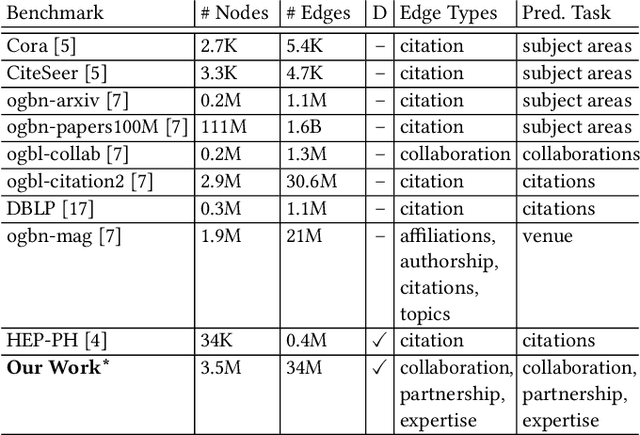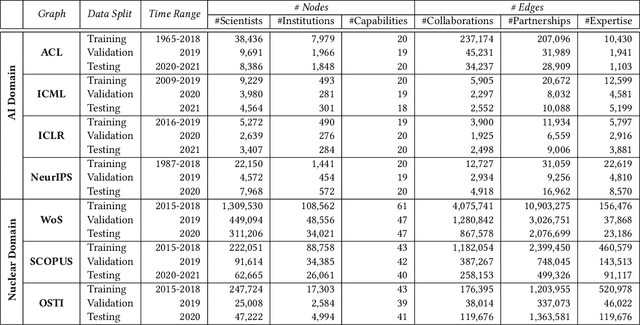Anastasiya Usenko
Anticipating Technical Expertise and Capability Evolution in Research Communities using Dynamic Graph Transformers
Jul 18, 2023Abstract:The ability to anticipate technical expertise and capability evolution trends globally is essential for national and global security, especially in safety-critical domains like nuclear nonproliferation (NN) and rapidly emerging fields like artificial intelligence (AI). In this work, we extend traditional statistical relational learning approaches (e.g., link prediction in collaboration networks) and formulate a problem of anticipating technical expertise and capability evolution using dynamic heterogeneous graph representations. We develop novel capabilities to forecast collaboration patterns, authorship behavior, and technical capability evolution at different granularities (e.g., scientist and institution levels) in two distinct research fields. We implement a dynamic graph transformer (DGT) neural architecture, which pushes the state-of-the-art graph neural network models by (a) forecasting heterogeneous (rather than homogeneous) nodes and edges, and (b) relying on both discrete -- and continuous -- time inputs. We demonstrate that our DGT models predict collaboration, partnership, and expertise patterns with 0.26, 0.73, and 0.53 mean reciprocal rank values for AI and 0.48, 0.93, and 0.22 for NN domains. DGT model performance exceeds the best-performing static graph baseline models by 30-80% across AI and NN domains. Our findings demonstrate that DGT models boost inductive task performance, when previously unseen nodes appear in the test data, for the domains with emerging collaboration patterns (e.g., AI). Specifically, models accurately predict which established scientists will collaborate with early career scientists and vice-versa in the AI domain.
EXPERT: Public Benchmarks for Dynamic Heterogeneous Academic Graphs
Apr 14, 2022



Abstract:Machine learning models that learn from dynamic graphs face nontrivial challenges in learning and inference as both nodes and edges change over time. The existing large-scale graph benchmark datasets that are widely used by the community primarily focus on homogeneous node and edge attributes and are static. In this work, we present a variety of large scale, dynamic heterogeneous academic graphs to test the effectiveness of models developed for multi-step graph forecasting tasks. Our novel datasets cover both context and content information extracted from scientific publications across two communities: Artificial Intelligence (AI) and Nuclear Nonproliferation (NN). In addition, we propose a systematic approach to improve the existing evaluation procedures used in the graph forecasting models.
 Add to Chrome
Add to Chrome Add to Firefox
Add to Firefox Add to Edge
Add to Edge